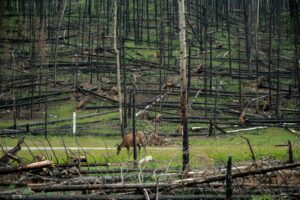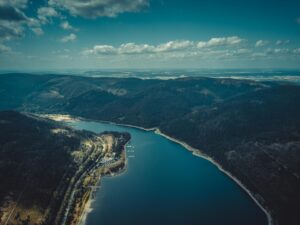In a global scenario marked by unprecedented environmental challenges, the interconnection between biodiversity and nature-based solutions (NBS) emerges as a fundamental pillar for building a more resilient and sustainable future. The accelerated loss of species, the degradation of ecosystems, and the growing threats of climate change impose an urgent need for the adoption of innovative approaches that integrate nature conservation with socioeconomic development. This article delves into the understanding of these two intrinsically linked concepts, exploring their importance, synergies, practical applications, and the transformative potential they represent for overcoming contemporary challenges.
Biodiversity, at its core, represents the tapestry of life on Earth, encompassing the variety of living things at all levels of organization – from genetic diversity within the same species to the complexity of ecosystems and landscapes. It is the foundation on which vital ecosystem services are sustained, ranging from air and water purification to crop pollination and climate regulation. However, this natural wealth is under constant threat, driven by human activities that result in habitat loss, pollution, overexploitation of resources, and, increasingly prominently, climate change.
At the same time, Nature-Based Solutions (NBS) emerge as a promising response to these challenges. Defined as actions that protect, sustainably manage, and restore natural or modified ecosystems, NBS aim to address societal challenges in an effective and adaptive manner, while providing benefits for human well-being and biodiversity. They represent a paradigm shift, moving away from purely technological or engineering solutions to embrace the intelligence inherent in natural processes. Instead of building concrete flood barriers, for example, NBS propose restoring mangroves or creating wetlands, which not only protect against disasters but also serve as nurseries for marine life and carbon sinks.
The urgency of integrating biodiversity and NBS is undeniable. Science has shown that ecosystem degradation and biodiversity loss exacerbate the impacts of climate change, while the conservation and restoration of healthy ecosystems can play a crucial role in mitigating and adapting to these impacts. This article will explore in detail how this synergy can be leveraged to create a more sustainable future, covering everything from the fundamental concepts to practical examples of implementation at various scales and contexts. We will look at the challenges and opportunities, the role of public policy and governance, and the prospects for research and innovation in this vital field. By the end, the reader is expected to understand the depth of the relationship between biodiversity and NBS, and the imperative to adopt these approaches as an essential pathway to the health of the planet and the well-being of present and future generations.
Biodiversity: Pillar of Life on Earth

Biodiversity, or biological diversity, is a concept that transcends mere species counting. It encompasses the variability of life at all levels of organization, from genetic complexity within the same population to the richness of ecosystems and landscapes. This intricate web of life is the result of billions of years of evolution and interactions, shaping the planet and providing the essential conditions for human existence. To understand biodiversity in its fullness is to recognize that we are an integral part of a larger system, and that the health of that system is directly proportional to our own health and well-being.
Levels of Biodiversity
For a more in-depth understanding, biodiversity can be categorized into three main levels:
- **Genetic Diversity:** Refers to the variation of genes within the same species. This diversity is crucial to a species’ ability to adapt to environmental changes, resist disease, and thrive in different conditions. For example, genetic variability in agricultural crops is critical for the development of varieties that are more resistant to pests or droughts, ensuring food security. The loss of genetic diversity can make populations more vulnerable and less able to evolve in response to new challenges.
- **Species Diversity:** It is the level most commonly associated with biodiversity, representing the variety of species of plants, animals, fungi, and microorganisms in a given region or on the planet as a whole. Each species plays a unique role in the ecosystem, and the loss of a single species can trigger a ripple effect, affecting other species and ecosystem functionality. Brazil, for example, is recognized as one of the megadiverse countries, home to a significant portion of global biodiversity, with a wide range of endemic species and unique ecosystems.
- **Diversity of Ecosystems:** It encompasses the variety of habitats, biological communities, and ecological processes that occur in different regions. This includes forests, oceans, rivers, deserts, mountains, swamps, and many others. Each ecosystem has distinct characteristics and is home to a specific set of species that interact with each other and with the physical environment. The diversity of ecosystems ensures the planet’s resilience to disturbances and the maintenance of multiple ecosystem services.
Importance of Ecosystem Services]

Biodiversity is the basis for the provision of numerous ecosystem services, which are the benefits that humans derive from ecosystems. These services are often classified into four categories:
- Provision Services: These include direct products obtained from nature, such as food (fruits, vegetables, meat, fish), fresh water, wood, fibers, fuels, and genetic resources for medicines and biotechnology. The maintenance of biodiversity is essential for food and water security, and for the development of new products and technologies.
- **Regulation Services:** Refer to the benefits obtained from the regulation of ecosystem processes. This includes climate regulation (carbon sequestration by forests and oceans), air and water purification, flood and drought control, disease and pest control, and pollination of agricultural crops. The degradation of these services can lead to extreme weather events, water scarcity, and disease outbreaks.
- **Support Services:** These are the processes necessary for the production of all other ecosystem services. This encompasses soil formation, nutrient cycling, primary production (photosynthesis), and water cycling. These services operate on longer timescales and are critical to the maintenance of life on Earth.
Cultural Services: Encompass the non-material benefits that people derive from ecosystems through spiritual enrichment, cognitive development, reflection, recreation, and aesthetic experiences. These include the value of nature for tourism, outdoor recreation, artistic inspiration, and the maintenance of cultural identities linked to specific landscapes.
Threats to Biodiversity

Despite its inestimable importance, global biodiversity is facing an unprecedented crisis, driven primarily by human activities. Top threats include:
Habitat Loss and Fragmentation: The conversion of natural areas for agriculture, urbanization, infrastructure, and other human activities is the leading cause of biodiversity loss. Habitat fragmentation isolates populations, reducing genetic diversity and making species more vulnerable to extinction.
Climate Change: Global warming, caused primarily by greenhouse gas emissions, is altering weather patterns, raising sea levels, and acidifying the oceans. This results in changes in species distribution, more frequent and intense extreme weather events, and the loss of sensitive ecosystems such as coral reefs and boreal forests.
Pollution: Contamination of air, water, and soil by industrial, agricultural, and domestic pollutants directly affects the health of organisms and the integrity of ecosystems. Pollutants such as plastics, pesticides, and heavy metals can have devastating effects on wildlife and ecosystem services.
Invasive Species: The introduction of alien species into new environments, whether intentionally or accidentally, can unbalance native ecosystems by competing with local species for resources, preying on them, or transmitting disease. This can lead to the extinction of native species and the simplification of ecosystems.
Excessive Resource Exploitation: Overfishing, poaching, unsustainable deforestation, and over-extraction of natural resources lead to the depletion of species populations and the degradation of ecosystems. Growing demand for resources, driven by rising population and consumption, exacerbates this threat.
Consequences of Biodiversity Loss

Biodiversity loss has profound and multifaceted consequences, affecting not only the environment but also the economy, human health, and social stability. Among the main consequences, the following stand out:
* **Impairment of Ecosystem Services:** Decreasing biodiversity reduces the ability of ecosystems to provide essential services such as clean water, clean air, pollination, and climate regulation. This can lead to water crises, food insecurity, and increased vulnerability to natural disasters.
Increased Vulnerability to Disease: Healthy, biodiverse ecosystems are more resilient to disease and pests. Biodiversity loss can create favorable conditions for the emergence and spread of zoonotic diseases, with significant impacts on public health.
* **Economic Impacts:** Sectors such as agriculture, fishing, forestry, and tourism depend directly on biodiversity. Environmental degradation and species loss can result in substantial economic losses, affecting livelihoods and regional development.
Loss of Traditional Knowledge: Many indigenous and local communities have a wealth of knowledge about biodiversity and its sustainable use. The loss of species and ecosystems can lead to the erosion of this valuable knowledge, with cultural and social implications.
Reduced Ecosystem Resilience: Ecosystems with lower biodiversity are less able to recover from disturbances, such as fires, droughts, or floods. This makes them more susceptible to collapse and the irreversible loss of ecological functions.
Given this scenario, the conservation of biodiversity is not only an environmental issue, but an ethical, social, and economic imperative. It is in this context that Nature-Based Solutions emerge as a promising strategy, offering a path to reverse environmental degradation and build a more harmonious future with nature.
Nature-Based Solutions (NBS): Concepts and Principles

In response to growing environmental and social challenges, a new paradigm has gained prominence on the global stage: Nature-Based Solutions (NbS). This concept represents an innovative approach that draws inspiration and support from natural processes and ecosystems to tackle complex problems such as climate change, water security, disaster risk management, and human health. Far from being a panacea, NBS offer a promising path to building a more sustainable future, integrating nature conservation with socio-economic development in a synergistic way.
Origin and Evolution of the NBS Concept
The term “Nature-based Solutions” (NbS) began to gain traction in the early 2000s, popularized by organizations such as the International Union for Conservation of Nature (IUCN). Initially, the concept was more focused on biodiversity conservation and ecosystem restoration. However, over time, its definition has evolved to encompass a broader range of actions that utilize nature to solve societal challenges, recognizing that the health of ecosystems is intrinsically linked to human well-being.
IUCN defines NBS as “actions to protect, sustainably manage, and restore natural or modified ecosystems, which address societal challenges effectively and adaptively, while providing benefits for human well-being and biodiversity” [1]. This comprehensive definition highlights the multifunctionality of NBS, which goes beyond a single objective, seeking to generate multiple benefits for society and the environment.
Fundamental Principles of NBS
The successful implementation of Nature-Based Solutions is guided by a set of fundamental principles that ensure their effectiveness and long-term sustainability. These principles include:
- **Multiple Benefits:** NBS are designed to generate a variety of simultaneous benefits. For example, restoring a riparian forest can not only improve water quality and protect against flooding, but also increase local biodiversity, provide recreation opportunities, and sequester carbon. This cross-functional approach makes them more attractive and efficient than solutions that only target a single problem.
- Adaptability and Resilience: NBS are inherently adaptive and contribute to the resilience of socio-ecological systems. By working with natural processes, they can adjust to changing environmental conditions, such as those caused by climate change. For example, a restored coastal dune system may adapt better to storms and sea level rise than a rigid concrete structure.
- Participation and Inclusion: The design and implementation of NBS should involve local communities and relevant stakeholders. Active participation ensures that solutions are culturally appropriate, socially just, and that they meet the needs and priorities of the people who will be most directly affected. Traditional knowledge and local practices are often valuable for the success of NBS.
- **Scientific Basis and Traditional Knowledge:** NbS should be based on sound scientific evidence and, where appropriate, integrate traditional and indigenous knowledge. The combination of different forms of knowledge can lead to more robust and effective solutions, adapted to local conditions.
- Integration and Systemic Approach: NBS should be integrated into planning and development strategies at different scales, from the local to the national and global levels. They should be seen as part of a systemic approach to landscape and natural resource management, rather than isolated solutions.
- **Long-Term Sustainability:** NBS should be planned and managed to ensure their long-term sustainability, considering social, economic, and environmental impacts. This includes the need for adequate funding, ongoing monitoring, and adaptation to changes over time.
Difference Between NbS and Traditional Engineering Approaches

While Nature-Based Solutions can complement traditional engineering approaches, they are distinguished by their philosophy and methodology. Conventional engineering solutions often involve the construction of rigid and gray infrastructures, such as dikes, dams, and complex drainage systems, which seek to control natural processes. While effective in certain situations, these approaches can be expensive, have negative environmental impacts, and are often not adaptable in the long term in the face of a changing climate.
NBS, on the other hand, work *with* nature, rather than *against* it. They use ecological processes and the characteristics of ecosystems to provide services and solve problems. For example, instead of building a concrete retaining wall to protect a coastal area from erosion, a NbS could involve restoring dunes and coastal vegetation, which naturally absorb wave energy and stabilize the soil. This approach is often more cost-effective, more resilient, and offers multiple additional benefits, such as improving biodiversity and creating green spaces for recreation.
NbS Categories
Nature-Based Solutions can be classified into different categories, depending on the type of intervention and the main objective. While there is overlap, the main categories include:
- **Protection and Conservation of Ecosystems:** Focuses on maintaining the integrity and functionality of existing healthy ecosystems. This includes the creation and management of protected areas, the conservation of primary forests, the protection of wetlands, and the preservation of critical habitats for endangered species. By protecting these ecosystems, we ensure the continuity of the ecosystem services they provide.
- Restoration of Degraded Ecosystems: This involves the recovery of ecosystems that have been damaged or destroyed by human activities. Examples include the reforestation of deforested areas, the restoration of degraded rivers and streams, the restoration of mangroves and coral reefs, and the rehabilitation of contaminated soils. Restoration aims to restore the structure, function, and biodiversity of ecosystems, allowing them to return to providing essential services.
- Sustainable Ecosystem Management: This refers to the management of ecosystems in a way that ensures the continuous production of goods and services while maintaining their health and ecological integrity. This includes practices such as sustainable agriculture, responsible forestry, sustainable fisheries, and integrated landscape management. The goal is to balance human needs with the carrying capacity of ecosystems.
- **Creation of New Ecosystems:** In some cases, NBS may involve the creation of new ecosystems or natural features in environments where they did not previously exist, or where they have been completely lost. Examples include the construction of rain gardens in urban areas to manage stormwater runoff, the creation of green roofs for thermal insulation and biodiversity, and the implementation of constructed wetlands for wastewater treatment. These interventions seek to mimic natural processes to provide specific benefits.
By understanding these concepts and principles, it becomes evident that Nature-Based Solutions are not just a trend, but an urgent need to address global challenges. They represent a fundamental shift in the way we interact with the environment, recognizing the intrinsic value of nature and its irreplaceable role in building a prosperous and equitable future. The next section will explore the synergy between biodiversity and NBS, demonstrating how these two elements are mutually reinforcing to maximize benefits for the planet and society.
[1] IUCN. (n.d.). *Nature-based Solutions*. Retrieved from https://www.iucn.org/our-work/nature-based-solutions
The Synergy between Biodiversity and NBS
 The relationship between biodiversity and Nature-Based Solutions (NbS) is not merely incidental; It’s a deep and mutually beneficial synergy that amplifies the effectiveness of both approaches. NBS intrinsically depend on biodiversity to function fully, while in turn actively promoting the conservation and enrichment of biological diversity. This interdependence is key to unlocking the transformative potential of NBS in solving complex socio-environmental challenges.
The relationship between biodiversity and Nature-Based Solutions (NbS) is not merely incidental; It’s a deep and mutually beneficial synergy that amplifies the effectiveness of both approaches. NBS intrinsically depend on biodiversity to function fully, while in turn actively promoting the conservation and enrichment of biological diversity. This interdependence is key to unlocking the transformative potential of NBS in solving complex socio-environmental challenges.
How NBS Promote Biodiversity Conservation
Nature-Based Solutions are, by definition, actions that aim to protect, sustainably manage and restore ecosystems. In doing so, they contribute directly to biodiversity conservation on multiple levels:
Habitat Protection: Many NBS involve the creation or expansion of protected areas, the conservation of forests, wetlands, mangroves, and other critical ecosystems. These actions safeguard the natural habitats of numerous species, preventing the loss and fragmentation that are the main causes of extinction.
Ecological Restoration: Restoration of degraded ecosystems is a central component of NBS. By rehabilitating forests, rivers, coral reefs, or coastal areas, NBS recreate the conditions necessary for wildlife to return and flourish. This not only increases the number of species, but also restores ecological interactions and the processes that underpin ecosystem health.
* **Improvement of Environmental Quality:** NbS, such as phytoremediation (use of plants to remove pollutants) or the creation of wetlands for wastewater treatment, improve air, water, and soil quality. A cleaner and healthier environment is critical to the survival and prosperity of many species, including those sensitive to pollution.
Landscape Connectivity: By restoring ecological corridors and removing barriers, NBS increase connectivity between different habitat fragments. This allows species to move freely, access resources, find mates, and adapt to climate change, reducing the risk of genetic isolation and local extinction.
Reducing Anthropogenic Pressures: By providing solutions to societal challenges, such as water security or disaster protection, NBS can reduce pressure on natural resources. For example, sustainable water management can decrease the need for over-extraction of aquifers, protecting aquatic ecosystems and the species that depend on them.
How Biodiversity Strengthens the Effectiveness of NBS

Just as NBS benefit biodiversity, biodiversity itself is a crucial factor for the success and resilience of Nature-Based Solutions. More diverse ecosystems are inherently more robust and able to provide ecosystem services more effectively:
Increased Resilience to Disturbances: Ecosystems with high species diversity and genetics are more resilient to shocks and stresses, such as droughts, floods, pests, or diseases. If one species is affected, others can take over their functions, ensuring the continuity of ecosystem services. This functional redundancy is vital for long-term NBS stability.
* **Improved Performance of Ecosystem Services:** Functional diversity within an ecosystem can optimize service delivery. For example, a variety of plant species with different root systems can improve soil stability and water infiltration more effectively than a monoculture. Likewise, the diversity of pollinators ensures agricultural productivity.
Adaptability to Climate Change: Genetic and species diversity allows ecosystems to better adapt to climate change. Populations with greater genetic variability are more likely to have individuals with traits that allow them to survive and thrive in new climatic conditions. This is critical for the longevity of NBS in a scenario of climate uncertainty.
* **Innovation and New Solutions:** Biodiversity is an inexhaustible source of inspiration for innovation. Biomimicry, for example, seeks solutions to human challenges by mimicking designs and processes found in nature. The greater the biodiversity, the greater the potential to discover new solutions and technologies that can be incorporated or improved by NBS.
Practical Examples of Synergy
The synergy between biodiversity and NBS can be observed in a variety of practical applications:
Coastal Ecosystem Restoration: Mangrove and coral reef restoration is a classic example of NbS that directly benefits biodiversity. Mangroves provide crucial habitats for fish, crustaceans, and birds, while protecting coastal communities from storms and erosion. Coral reefs are home to a huge diversity of marine life and act as natural barriers against waves. Restoring these ecosystems not only increases biodiversity, but also strengthens coastal resilience.
Urban Green Infrastructure: The implementation of urban parks, green roofs, rain gardens, and green corridors in cities are NbS that bring multiple benefits. They increase local biodiversity (by attracting birds, pollinating insects), improve air quality, reduce the urban heat island effect, manage stormwater runoff, and provide leisure and well-being spaces for citizens. The plant diversity and structural complexity of these green spaces are crucial to maximizing these benefits.
Regenerative Agriculture and Agroforestry: Agricultural practices that promote soil health, crop diversity, and tree integration (agroforestry) are NbS that increase biodiversity in the agricultural environment. This results in more fertile soils, greater natural pest control, reduced need for chemical inputs, and greater resilience to extreme weather events. The diversity of cultivated species and the presence of native vegetation contribute to the health of the agricultural ecosystem as a whole.
* **Sustainable Watershed Management:** The protection and restoration of riparian forests, the conservation of springs and the integrated management of watersheds are NbS that guarantee the quality and availability of water. By protecting native vegetation along rivers, soil erosion, sedimentation and water pollution are avoided, benefiting aquatic life and associated biodiversity. The ecological integrity of the watershed is critical to the water security of downstream communities.
In all these examples, biodiversity is not only a beneficiary of NBS, but an active and essential component for their success. The complexity and richness of natural systems are what allow them to provide such a wide range of services and adapt to ever-changing conditions. Recognizing and valuing this synergy is the first step to designing and implementing NBS that are truly effective and sustainable in the long term. The next section will detail the various applications of NBS in different contexts, further illustrating this powerful interconnectedness.
Applications and Examples of NBS in Different Contexts
Nature-Based Solutions (NbS) are remarkably versatile, adaptable to a wide range of geographical contexts and socio-environmental challenges. Its application extends from dense urban centers to vast rural landscapes, passing through coastal ecosystems and watersheds. The beauty of NBS lies in its ability to mimic and enhance natural processes, offering solutions that are not only effective, but also multifunctional, generating environmental, social, and economic benefits. This section will explore the many ways in which NBS are being implemented in different settings, with practical examples illustrating their transformative potential.
NBS in Urban Environments

Cities, centers of much of the world’s population and hubs of economic activity, are also environments that face significant environmental challenges, such as the heat island effect, flooding, air pollution, and biodiversity loss. NBS offers innovative approaches to making cities greener, more resilient and more livable:
* **Urban Parks and Green Areas:** The creation and maintenance of parks, squares and green belts within cities are fundamental NbS. They act as urban lungs, improving air quality, reducing ambient temperatures, providing spaces for recreation and recreation, and serving as refuges for wildlife. Well-planned parks can also help with stormwater management, absorbing excess rainfall and reducing the risk of flooding.
Green Roofs and Green Walls: The installation of vegetation on roofs and building facades is a growing NBS in urban environments. Green roofs help insulate buildings, reducing energy consumption for heating and cooling, and absorb rainwater, decreasing surface runoff. Green walls contribute to improved air quality, reduced noise, and increased urban aesthetics. Both systems can create new habitats for insects and birds, increasing local biodiversity.
* **Rain Gardens and Retention Basins:** Designed to collect and filter rainwater, rain gardens and retention basins are NbS that manage surface runoff, reduce the load on drainage systems and recharge aquifers. By utilizing native plants, these systems also contribute to biodiversity and create more attractive urban landscapes.
Green Corridors and Tree-Lined Bike Paths: The creation of networks of green spaces that connect different areas of the city not only facilitates sustainable mobility but also serves as ecological corridors, allowing for the movement of species and the dispersal of seeds. This increases the connectivity of the urban landscape and strengthens biodiversity.
NbS in Coastal and Marine Environments
Coastal areas and oceans are vitally important ecosystems, but they are under increasing pressure due to rising sea levels, coastal erosion, pollution and overfishing. NBS offer effective solutions to protect these areas and the communities that depend on them:
Mangrove Restoration and Protection: Mangroves are incredibly valuable coastal ecosystems. They act as natural barriers against storms and tsunamis, prevent coastal erosion, filter pollutants from the water, and serve as nurseries for a vast array of marine species and birds. The restoration of degraded mangroves is a crucial NbS for coastal protection and the conservation of marine biodiversity.
Coral Reef Restoration: Coral reefs are marine ecosystems of high biodiversity, which provide habitats for thousands of species and protect coasts from erosion. Restoring damaged reefs, through coral transplantation and the creation of artificial structures, is a NbS that aims to restore the health of these ecosystems and the services they provide.
Coastal Dunes and Beach Vegetation: The protection and restoration of coastal dunes and beach vegetation are effective NbS to stabilize shorelines, prevent erosion, and protect communities from extreme events. Native vegetation helps to fix sand and dissipate wave energy, while dunes act as natural barriers.
Sustainable Mariculture: Aquaculture practices that integrate nature, such as oyster and mussel farming, can improve water quality by filtering pollutants and providing habitats for other marine species. This is an NBS that combines food production with improved ecosystem health.
NBS in River Basins

Water management is a global challenge, with many regions facing scarcity, flooding, or pollution. NBS in river basins seek to restore and protect the natural processes that regulate the water cycle:
* **Restoration of Riparian Forests and Spring Areas:** Vegetation along rivers and streams (riparian forests) and the protection of springs are essential NbS for water quality and quantity. They filter pollutants, stabilize banks, reduce erosion, and regulate water flow, benefiting aquatic biodiversity and downstream communities.
Natural and Constructed Wetlands: Wetlands, such as swamps and wetlands, act as natural sponges, absorbing excess water during floods and slowly releasing it during periods of drought. They also filter pollutants and provide habitats rich in biodiversity. The restoration of degraded wetlands or the creation of constructed wetlands for wastewater treatment are effective NbS for water management.
Integrated Landscape Management: A holistic approach that considers the entire watershed, integrating different land uses and management practices to optimize ecosystem services. This can include promoting sustainable agricultural practices, reforestation in aquifer recharge areas, and managing forests to regulate water flow.
NbS in Agriculture and Forestry
The agricultural and forestry sectors are crucial to the economy and food security, but they can also be sources of environmental degradation. NBS offers ways to make these activities more sustainable and productive:
* **Agroforestry:** Agroforestry systems integrate trees, agricultural crops and/or livestock in the same area. This NbS increases biodiversity, improves soil fertility, reduces erosion, sequesters carbon and diversifies production, making agricultural systems more resilient and productive in the long term.
Regenerative Agriculture: A set of agricultural practices that aim to restore soil health, increase biodiversity, and improve the water cycle. This includes no-till, cover crops, crop rotation, and reducing the use of chemicals. Regenerative agriculture not only increases productivity but also contributes to climate change mitigation and biodiversity conservation.
* **Sustainable Forest Management:** Practices that ensure the production of wood and other forest products in order to maintain the health and integrity of forest ecosystems. This includes harvest planning, biodiversity protection, fire prevention, and the restoration of degraded areas. Sustainable forest management is an NBS that balances economic needs with environmental conservation.
Global and Country Case Studies
Several examples around the world demonstrate the success of NBS implementation:
The Project
Great Barrier Reef (GBR) in Australia:** Although not an NBS in the traditional sense of direct human intervention to solve a social problem, GBR conservation and management is an example of how protecting a high-biodiversity ecosystem provides crucial ecosystem services. Efforts to reduce the pollution of the water that reaches the reef and to mitigate the impacts of climate change are NbS that aim to protect this natural heritage and the benefits it offers, such as coastal protection and tourism. The health of the reef, in turn, is critical to the region’s marine biodiversity.
The Portland, Oregon Green Infrastructure Program: The City of Portland, Oregon, is a leading example in implementing green infrastructure to manage stormwater runoff. Instead of building more sewer pipes, the city invested in rain gardens, green roofs, and green streets that absorb and filter rainwater. These NBS have not only reduced the volume of sewage reaching rivers, but have also created green spaces, improved air quality, and increased urban biodiversity.
* **Atlantic Forest Restoration in Brazil:** Several projects in Brazil focus on the restoration of the Atlantic Forest, a highly biodiverse and fragmented biome. The restoration of riparian forests, for example, not only recovers local biodiversity, but also improves water quality, prevents soil erosion and contributes to climate regulation. These efforts are crucial for water security and biodiversity conservation in one of the country’s most densely populated regions.
These examples demonstrate that Nature-Based Solutions are applicable at various scales and contexts, offering effective and cross-functional approaches to address environmental and social challenges. The key to success lies in understanding local ecological processes, engaging communities, and integrating these solutions into long-term policies and planning. The next section will address the challenges and opportunities in implementing these solutions, as well as the crucial role of public policy and governance.
Challenges and Opportunities in Implementing NBS
Despite the growing recognition of the potential of Nature-Based Solutions (NbS) to address global challenges, their large-scale implementation still faces a number of obstacles. However, these challenges also open doors to significant opportunities for innovation, collaboration, and investment. Overcoming existing barriers is crucial for NBS to fulfill their transformative role in building a more sustainable and resilient future.
Barriers to Implementation

The widespread adoption of NBS is hampered by several barriers, which can be categorised as follows:
* **Financing:** One of the main barriers is the lack of adequate financing and innovative financial mechanisms. Many NBS, especially those with long-term and multiple benefits, may not fit into traditional investment models. There is a perception that they are more difficult to monetize or that their returns are less predictable compared to conventional infrastructure projects. In addition, the fragmentation of financing sources and the difficulty in accessing climate or biodiversity funds can delay or make projects unfeasible.
* **Policies and Regulatory Frameworks:** The absence or inadequacy of public policies and regulatory frameworks that support and encourage NBS is a significant obstacle. Often, existing legal and institutional frameworks are more favorable to traditional engineering solutions. The lack of clear guidelines, tax incentives, and simplified licensing mechanisms can discourage the adoption of NbS by governments, businesses, and communities.
Knowledge and Capacity: There is a knowledge and technical capacity gap regarding NBS planning, implementation, and monitoring. Professionals and decision-makers may not be familiar with NBS principles and best practices, or may lack the necessary skills to design and manage these complex projects. The lack of data and evidence on the effectiveness of NBS in different contexts can also hinder decision-making and investment justification.
Governance and Coordination: The cross-functional nature of NBS requires an integrated and collaborative approach, which often comes up against fragmented governance structures. Coordination between different sectors (water, energy, agriculture, urban planning), levels of government (municipal, state, federal) and stakeholders (private sector, civil society, local communities) is essential but often difficult to achieve. Conflicts of interest and the lack of inclusive participation mechanisms can also jeopardize the success of projects.
* **Perception and Acceptance:** In some cases, there may be a lack of understanding or acceptance of NBS by the public and decision-makers. The preference for engineering solutions
Traditional traditions, which are seen as more robust or immediate, can be an obstacle. Effective communication of the multiple and long-term benefits of NBS is key to overcoming this barrier.
Opportunities for Scalability
Despite the challenges, the landscape for NBS is promising, with several opportunities for its scalability and integration into development policies and practices:
Green Investment and Innovative Finance: There is a growing interest in green and sustainable investments, which opens doors for NbS financing. Mechanisms such as green bonds, impact funds, payments for environmental services (PES), and public-private partnerships can mobilize significant resources. The economic valuation of ecosystem services provided by NBS can attract investors seeking financial and environmental returns.
Innovation and Technology: Technology plays a crucial role in optimizing and scaling NbS. Remote sensing, climate modeling, artificial intelligence, and big data tools can assist in planning, monitoring, and evaluating the effectiveness of NbS. Innovation in restoration materials and techniques can also reduce costs and increase efficiency.
* **Collaboration and Partnerships:** The intersectoral nature of NBS requires collaboration between governments, the private sector, academia, civil society, and local communities. Forming strategic partnerships can leverage resources, share knowledge and experiences, and create synergies that drive large-scale implementation. Knowledge platforms and practice networks can facilitate the exchange of information and mutual learning.
* **Integration in Policy and Planning:** The integration of NBS into existing public policies and development plans is fundamental for their institutionalization. This includes incorporating NBS into climate adaptation and mitigation plans, urban master plans, river basin plans, and biodiversity conservation strategies. Creating specific targets and indicators for NBS can boost their adoption.
**Public Awareness and Engagement:** Raising awareness of the benefits of NBS and engaging the public in their implementation can generate support and demand for these solutions. Environmental education campaigns, citizen science programs, and volunteering initiatives can strengthen people’s connection with nature and promote active participation in building a greener future.
The Role of Science, Technology and Innovation
Science, technology and innovation are essential pillars for the advancement of Nature-Based Solutions. Scientific research deepens our understanding of ecological processes and ecosystem services, providing the knowledge base needed to design and implement effective NbS. Technology, in turn, offers tools to monitor, model, and optimize NBS performance, in addition to allowing the dissemination of information and the engagement of different actors.
Research and Development: Investments in research and development are crucial to improve restoration techniques, develop new approaches to sustainable management, and assess the effectiveness of NbS in different contexts. Interdisciplinary research, which combines ecology, engineering, economics and social sciences, is key to addressing the complexity of NbS.
* **Monitoring and Evaluation:** Continuous monitoring and rigorous evaluation of NBS performance is essential to ensure its effectiveness and to identify opportunities for improvement. The use of technologies such as remote sensing, drones, and sensor networks can provide real-time data on the health of ecosystems and the provision of ecosystem services.
Knowledge Transfer and Capacity Building: Translating scientific knowledge into applicable practices and building the capacity of practitioners and communities are key to the scalability of NBS. Training programs, good practice manuals, and knowledge-sharing platforms can accelerate adoption and improve the quality of implementation.
By overcoming challenges and seizing opportunities, Nature-Based Solutions can become a powerful tool for addressing the climate crisis and biodiversity loss, while promoting sustainable development and human well-being. The next section will address the crucial role of public policy and governance in creating an enabling environment for large-scale implementation of NBS.
Public Policy and Governance for NBS
The successful implementation and scalability of Nature-Based Solutions (NbS) fundamentally depends on a favorable political and governance environment. Without clear regulatory frameworks, adequate incentives, and effective coordination between different levels of government and stakeholders, the transformative potential of NBS may remain untapped. This section explores the crucial role of public policy and governance in promoting and integrating NBS into sustainable development strategies.
Regulatory Frameworks and International Agreements
The recognition of NBS in international agreements and conventions is a fundamental step towards their legitimization and global adoption. Several regulatory frameworks and international agreements already provide a basis for the integration of NBS:
* **Convention on Biological Diversity (CBD):** The CBD, with its objectives of biodiversity conservation, sustainable use of its components, and fair and equitable sharing of benefits derived from the use of genetic resources, is a pillar for NBS. The Aichi Biodiversity Targets, while not explicitly mentioning NBS, encourage actions that align with its principles, such as ecosystem restoration and the integration of biodiversity into other sectors. The new Post-2020 Global Biodiversity Framework (Kunming-Montreal Framework) is likely to further highlight NBS as tools for achieving conservation and sustainable use goals.
Paris Agreement on Climate Change: The Paris Agreement recognizes the importance of ecosystems in mitigating and adapting to climate change. Countries’ Nationally Determined Contributions (NDCs) can and increasingly include nature-based actions, such as reforestation, wetland restoration, and sustainable land management, as part of their efforts to reduce emissions and increase resilience. NBS are seen as a cost-effective way to achieve multiple climate and development goals.
* **Sustainable Development Goals (SDGs):** Several SDGs are directly related to NBS, including SDG 6 (Clean Water and Sanitation), SDG 11 (Sustainable Cities and Communities), SDG 13 (Climate Action), SDG 14 (Life Below Water) and SDG 15 (Life on Land). NBS can contribute significantly to the achievement of multiple SDG targets, demonstrating their ability to generate cross-cutting benefits.
* **Sendai Framework for Disaster Risk Reduction:** This framework recognizes the importance of ecosystem-based approaches to disaster risk reduction. The protection and restoration of coastal ecosystems, forests, and wetlands can act as natural barriers, reducing vulnerability to floods, landslides, and storms.
National and Local Policies in Support of NBS
In addition to international agreements, it is critical for countries to develop and implement national and local policies and strategies that promote NBS. This may include:
National Biodiversity Strategies and Action Plans: Integrating NBS into these documents can ensure that conservation and sustainable use of nature are addressed holistically, considering their multiple benefits.
* **Climate Adaptation and Mitigation Plans:** The inclusion of NbS as key components in national and subnational climate plans can leverage investments and ensure that solutions are based on healthy ecosystems.
Legislation and Regulation: The creation of laws and regulations that encourage or require the adoption of NBS in sectors such as urban planning, water resources management, agriculture, and infrastructure. This may include tax incentives, subsidies, or the prioritization of NBS projects in permitting processes.
Economic Instruments: The development of innovative financial mechanisms, such as payments for environmental services (PES), green funds, and carbon and biodiversity markets, can create economic incentives for the implementation of NbS.
Spatial Planning and Land Use: Incorporating NBS into urban master plans, zoning, and watershed management plans can ensure that natural spaces are protected and restored, and that green infrastructure is integrated into territorial development.
The Importance of Civil Society and Local Community Participation

NbS governance should not be a one-way street, dictated only by governments and experts. The active participation of civil society, including non-governmental organizations, academia, the private sector, and, crucially, local communities and indigenous peoples, is essential to the success and legitimacy of NbS. These stakeholders bring valuable knowledge, diverse perspectives, and a sense of ownership that are critical to the sustainability of projects.
Traditional and Local Knowledge: Local communities and indigenous peoples have a vast knowledge of their ecosystems and sustainable management practices that have been developed over generations. Integrating this knowledge with modern science can lead to more effective and culturally appropriate solutions.
Engagement and Empowerment: Participation of communities in the planning and implementation of NBS ensures that solutions meet their needs and priorities, and that benefits are distributed fairly. Empowering communities to manage their own natural resources is a key component of effective NbS governance.
Monitoring and Accountability: Civil society can play an important role in monitoring the implementation of NBS and ensuring accountability by governments and other actors. This contributes to the transparency and effectiveness of policies.
Advocacy and Awareness: Civil society organisations play a vital role in advocating for NBS, raising public awareness and mobilising political support for their adoption. They can act as bridges between science, policy, and communities.
In short, a robust public policy framework and inclusive and participatory governance are indispensable for Nature-Based Solutions to be implemented on a large scale and generate the multiple benefits they promise. Collaboration between all sectors of society is the key to building a future where nature is seen not only as a resource to be exploited, but as an essential partner in solving humanity’s most pressing challenges. The next and final section will address the future of biodiversity and NBS, and the role of each in building a sustainable future.
The Future of Biodiversity and NBS
As we move into the 21st century, the intersection between biodiversity and Nature-Based Solutions (NbS) becomes increasingly central to the vision of a sustainable future. Environmental challenges, such as climate change and biodiversity loss, are complex and interconnected, requiring holistic and integrated approaches. In this context, NBS emerge not only as effective tools to mitigate and adapt to these challenges, but also as a pathway to redefine our relationship with the natural world, recognizing their intrinsic value and their ability to provide us with the solutions we need.
Future Scenarios and the Vision of a More Resilient World

The future of biodiversity and NBS may follow different trajectories, depending on the choices we make today. An optimistic scenario envisions a world where NBS are widely adopted and integrated at all levels of planning and development. In this future, cities would be greener and more resilient, with natural infrastructure that manages water, purifies the air, and provides well-being to citizens. Rural landscapes would be characterized by regenerative agricultural systems and sustainably managed forests, which produce food and resources while conserving biodiversity and sequestering carbon.
In this scenario, nature would be seen as a strategic ally, and not as an obstacle to development. The economy would be aligned with planetary boundaries, and investments would be directed towards solutions that generate multiple benefits for people and the planet. Collaboration between governments, the private sector, academia and civil society would be the norm, driving innovation and large-scale implementation of NbS. Education and awareness about the importance of biodiversity and NbS would be disseminated, fostering a culture of respect and care for the environment.
On the other hand, a pessimistic scenario, if current trends of environmental degradation persist, would lead to even greater biodiversity loss, more frequent and intense extreme weather events, and a collapse of essential ecosystem services. In this future, humanity would face water crises, food insecurity, natural disasters, and social conflicts exacerbated by resource scarcity. The resilience of natural and human systems would be severely compromised, making adaptation to the impacts of climate change increasingly difficult and costly.
It is from this bifurcation of paths that the urgency to act becomes evident. NBS offer an opportunity to steer the future towards the optimistic scenario, building a more resilient, equitable world in harmony with nature.
The Need for an Integrated and Systemic Approach
For NBS to reach their full potential, it is imperative to adopt an integrated and systemic approach. This means going beyond isolated projects and thinking about how NBS can be incorporated into development strategies at different scales and sectors. Some key considerations include:
Integrated Landscape Planning: Recognize that ecosystems are interconnected and that actions in one area can have impacts on others. Planning should consider the entire landscape, from river headwaters to coastal areas, integrating biodiversity conservation, water management, food production, and urban development.
Cross-border cooperation: Many ecosystems and environmental challenges transcend political boundaries. International and regional cooperation is essential for the implementation of NBS in shared watersheds, biodiversity corridors and marine protected areas.
Innovative and Sustainable Financing: Developing and implementing financial mechanisms that recognize the value of ecosystem services and encourage investments in NBS. This includes creating carbon and biodiversity markets, conservation funds, and public-private partnerships that mobilize capital for nature-based projects.
Strengthening Governance: Improving coordination between different levels of government and sectors, and ensuring the inclusive participation of all stakeholders, including local communities and indigenous peoples. Adaptive governance, which allows for adjustments and learnings over time, is crucial to the success of NBS.
Education and Capacity Building: Invest in education and capacity building programs for practitioners, decision-makers, and the general public on the principles and benefits of NBS. This will help build the capacity needed to plan, implement, and manage these solutions effectively.
The Role of Each Individual and Sector in Building a Sustainable Future

The transition to a future where biodiversity and NBS are central is not just the responsibility of governments or large organizations. Every individual, company and sector of society has a role to play:
Individuals: Can support NBS through conscious consumption choices, participation in conservation and restoration initiatives, and advocacy for policies that promote nature. Small actions, such as creating rain gardens at home or supporting regenerative agriculture products, can have a significant collective impact.
Private Sector: Companies can integrate NBS into their sustainability strategies by investing in restoration projects, adopting more sustainable production practices, and developing products and services that support biodiversity conservation. Recognizing the value of natural capital and the risks related to biodiversity loss can drive innovation and the creation of new business models.
Governments: They have a key role in creating a favorable policy and regulatory environment for NBS, investing in green infrastructure, developing integrated landscape management plans, and promoting cooperation between different levels of government and sectors.
* **Academia and Research:** Continue to generate scientific knowledge on biodiversity and NBS, developing new technologies and methodologies, and translating research into practical and accessible solutions. Collaboration with other stakeholders is crucial to ensure that the research is relevant and applicable.
* **Civil Society Organizations:** Continue to act as defenders of nature, mobilizing communities, monitoring policy implementation, and promoting awareness of the importance of biodiversity and NbS.
By joining forces and recognizing that nature is our greatest ally, we can build a future where biodiversity flourishes and Nature-Based Solutions are the norm, not the exception. This is the path to a healthier planet and a more prosperous future for all.
Conclusion
Throughout this article, we explore the deep and intrinsic relationship between biodiversity and Nature-Based Solutions (NbS), revealing how these two concepts are interdependent pillars for building a sustainable future. Biodiversity, the richness of life on our planet, is not just a collection of species, but the basis of all the essential ecosystem services that sustain human life. However, this vital base is under unprecedented threat, requiring urgent and effective action.
Nature-Based Solutions emerge as a powerful and multifaceted response to this crisis. Rather than fighting nature, NBS proposes to work with it, using its processes and inherent intelligence to solve complex societal challenges, from climate change mitigation and adaptation to water security and disaster risk reduction. We demonstrate how NBS not only promote biodiversity conservation, but are also strengthened by it, creating a virtuous cycle of environmental, social and economic benefits.
Through practical examples in urban and coastal settings, river basins, and sectors such as agriculture and forestry, we illustrate the versatility and transformative potential of NBS. We recognize, however, that the large-scale implementation of these solutions faces significant challenges, such as the need for innovative financing, favorable public policies, technical capacity building, and more integrated and participatory governance. Overcoming these barriers is imperative, and the opportunities for NBS scalability are vast, driven by innovation, collaboration, and a growing recognition of their value.
The future of biodiversity and NBS is in our hands. The vision of a more resilient world, where nature is a strategic ally in development, is achievable. To this end, it is critical to adopt an integrated and systemic approach, which transcends sectoral and geographical boundaries, and which involves the active participation of all actors in society – governments, the private sector, academia, civil society and, crucially, local communities and indigenous peoples. Every choice we make today, whether as an individual, company, or policymaker, will shape tomorrow’s landscape.
Let this article serve as a call to action. Research and innovation must continue to deepen our understanding and improve NbS practices. Public policies must create an enabling environment for its adoption. Investments should be directed towards solutions that value natural capital. And above all, we must cultivate a new relationship with nature, based on respect, collaboration and the recognition that the health of our planet is inseparable from our own well-being. Nature-Based Solutions are not just an option; They are an essential path to ensure a prosperous and equitable future for present and future generations.

Sem comentários